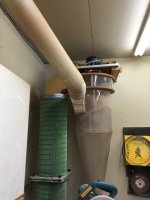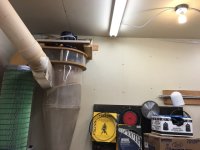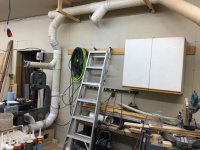So when I first started this adventure, I had no real idea where I wanted to end up. My day job was such that I just accumulated stuff knowing one day it would all fall into place and make sense. I had a number of different ideas about where and how to place my cyclone. This January I had no more day job, so I pulled everything out of my 15' X 25' X 10' H shop and covered the concrete with 1-1/2" styrofoam, 5/8" subfloor and 3/4" of some really badly milled birch flooring. This gave me an opportunity to reevaluate and make any required changes.
When I hung the cyclone in the left rear corner, I thought the filters would be better in the corner, so made that provision.
My noise levels are near 90db if the iphone apps are accurate. The concensus seems to be that most of the noise comes at the blower discharge, so I think I would like to rotate the Exit transition 180 degrees, extend the exit duct 3-4 feet, then drop to the filters. I can then enclose most of the cyclone and the additional transition duct in sound insulation.
I can move the cyclone closer to the left wall, which will allow me to eliminate some of the plumbing gyrations dropping down to my machines.
Any comments or suggestions.
Thanks
Don
PS
I need to dust my ducts. In my early days of experimenting, I turned on the cyclone with out the filters. Everything that was on the floor went everywhere. I think that having a plastic cyclone and duct will quickly identify any leakage of the exit side.
In my early days of experimenting, I turned on the cyclone with out the filters. Everything that was on the floor went everywhere. I think that having a plastic cyclone and duct will quickly identify any leakage of the exit side.
When I hung the cyclone in the left rear corner, I thought the filters would be better in the corner, so made that provision.
My noise levels are near 90db if the iphone apps are accurate. The concensus seems to be that most of the noise comes at the blower discharge, so I think I would like to rotate the Exit transition 180 degrees, extend the exit duct 3-4 feet, then drop to the filters. I can then enclose most of the cyclone and the additional transition duct in sound insulation.
I can move the cyclone closer to the left wall, which will allow me to eliminate some of the plumbing gyrations dropping down to my machines.
Any comments or suggestions.
Thanks
Don
PS
I need to dust my ducts.
Attachments
Last edited:



